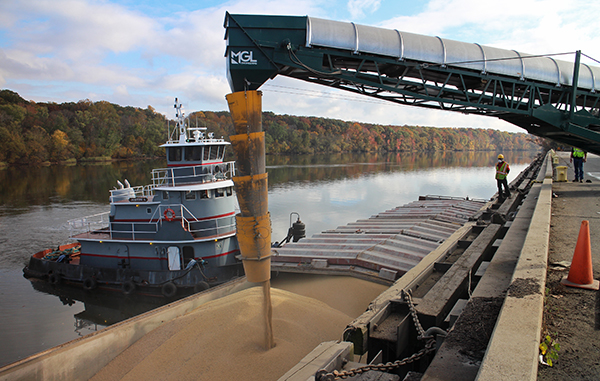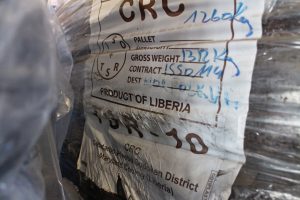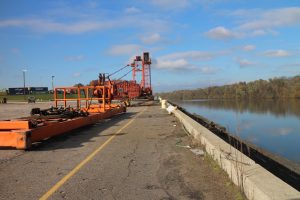Joe Harris watches as soybeans flow from a conveyer belt into a massive grain barge sitting on the James River, causing dust to billow up around the berth.
The beans are fresh off a train and in their transition from rail to river at the Port of Richmond. The boat sitting next to the grain barge, which is almost dwarfed by the enormous pile of beans, will pull it to Norfolk.
“It will take between 10 and 12 hours,” said Harris, spokesman for the Port of Virginia, which leases and operates Richmond’s city-owned riverfront port.
The beans belong to Perdue, one of the Port of Richmond’s customers. The chicken processing giant began operating out of the port about two years ago, as did Scholar Shipping., a grain exporter. The most recent customer, Singapore-based rubber importer R1 International, moved in this summer.
That list of new customers is just the start for the 121-acre facility, or so the Port of Virginia hopes. The brand, which has leased the Richmond facility since 2010 and is owned by the Virginia Port Authority, signed a 40-year-lease with the city in September. The VPA, through its Virginia International Terminals, operates six other facilities in the commonwealth.
The long-term lease will change things for the Port of Virginia in Richmond, giving it confidence to throw itself into capital improvements, encouraging even more customers and ocean carriers to put Richmond on the map.
“That long-term lease gives us a path forward,” Harris said. “We know we can make significant investments here.”
Richmond gets cargo from all over the world, including Liberia, Indonesia, Brazil and China. It receives goods ranging from soups and nuts to textiles, grains and car parts. And exports, like Perdue’s soybeans, come from all over the United States, including Central Virginia, before being shipped out to the world.
Its other customers include Philip Morris, WestRock, Lumber Liquidators, Luck Stone Corp., Expeditors International, Honeywell, Sims Medical and Turman Lumber.
“There’s potential here, there’s possibility,” Harris said. “Richmond pushes our reach 100 miles inland. So for a trucking company in Roanoke, by stopping here they’re shaving at least 200 miles off the journey because it’s coming here by barge. You’re meeting it halfway, in a sense.”
Over the course of this month, parts for a new mobile harbor crane will start to arrive at the 5000 Deepwater Terminal Road facility, replacing the 20-year-old machine that currently plucks massive containers from barges. The Port of Virginia received a $4.2 million federal grant for the new crane.
Improvements are also planned for the berth, the concrete area where ships moor, ensuring that it is strong enough to support the crane plus whatever it’s moving. And then workers will do maintenance dredging in the river, making sure it reaches down 22 feet.
The next move will be to expand 64 Express, the barge service that runs out of Richmond. Operated by the Norfolk Tug Co., the barge service currently carries 80 containers from Norfolk to Richmond three times a week. That capacity will increase to 125 containers and could jump up to a four-days-a-week service if the volume dictates, Harris said.
“All that will happen within the next year, probably more within the next six months,” he said.
The port is also in conversations with Norfolk Southern Railway, trying to lure it to Richmond. Right now CSX is the only rail service operating out of the port.
Harris did not say how much the Port of Virginia is investing in Richmond now that it has expanded its lease. He said that figure is unclear as the operator is still determining what needs to be done at the site such as how much of its 300,000 square feet of warehouse space is usable and what needs to be upgraded.
But already capacity has improved at the port, especially since the Port of Virginia took over. Around 15,000 containers have been transported to the Deepwater Terminal Road facility this year, more than twice as many as the 6,400 containers transported there in 2013.
Those improvements took place after a dismal run at the Richmond port. Just before the Port of Virginia took over, Richmond lost two of its major customers, locally based Eimskip and Iceland-based carrier ICL.
“It was just a victim of the economy,” Harris said. “Richmond had been a busy little port for many years, for decades. And then the ships got bigger and required more water … They just couldn’t get up here.”
But since the Port of Virginia took over in 2010, 10 major ocean carriers have created bills of lading for the Port of Richmond, which are similar to receipts for cargo.
“That means Richmond is on their map of destinations and points of origin,” Harris said.
Harris said officials envision the Port of Richmond having a similar trajectory as the Virginia Inland Port in Front Royal, Virginia.
“We opened in 1991, and people at that point said, you’re nuts, there’s no navigable water up here,” he said.
But the Port of Virginia saw it as a useful intersection of railways and interstates. Eventually, Harris said, companies started to see its value and began building facilities so they could be right next door and cut down on their travel time.
“Over the course of the next 20 years, we saw about $700 million in investments and 8,000 jobs created,” he said. “That is really our vision for this.”
He said the Port of Virginia is working with the city to encourage development around the Deepwater Terminal Road facility and to revitalize that portion of Commerce Road.
“We have a really good skeleton,” he said. “Now it’s time to put some meat back on the bones.”
Joe Harris watches as soybeans flow from a conveyer belt into a massive grain barge sitting on the James River, causing dust to billow up around the berth.
The beans are fresh off a train and in their transition from rail to river at the Port of Richmond. The boat sitting next to the grain barge, which is almost dwarfed by the enormous pile of beans, will pull it to Norfolk.
“It will take between 10 and 12 hours,” said Harris, spokesman for the Port of Virginia, which leases and operates Richmond’s city-owned riverfront port.
The beans belong to Perdue, one of the Port of Richmond’s customers. The chicken processing giant began operating out of the port about two years ago, as did Scholar Shipping., a grain exporter. The most recent customer, Singapore-based rubber importer R1 International, moved in this summer.
That list of new customers is just the start for the 121-acre facility, or so the Port of Virginia hopes. The brand, which has leased the Richmond facility since 2010 and is owned by the Virginia Port Authority, signed a 40-year-lease with the city in September. The VPA, through its Virginia International Terminals, operates six other facilities in the commonwealth.
The long-term lease will change things for the Port of Virginia in Richmond, giving it confidence to throw itself into capital improvements, encouraging even more customers and ocean carriers to put Richmond on the map.
“That long-term lease gives us a path forward,” Harris said. “We know we can make significant investments here.”
Richmond gets cargo from all over the world, including Liberia, Indonesia, Brazil and China. It receives goods ranging from soups and nuts to textiles, grains and car parts. And exports, like Perdue’s soybeans, come from all over the United States, including Central Virginia, before being shipped out to the world.
Its other customers include Philip Morris, WestRock, Lumber Liquidators, Luck Stone Corp., Expeditors International, Honeywell, Sims Medical and Turman Lumber.
“There’s potential here, there’s possibility,” Harris said. “Richmond pushes our reach 100 miles inland. So for a trucking company in Roanoke, by stopping here they’re shaving at least 200 miles off the journey because it’s coming here by barge. You’re meeting it halfway, in a sense.”
Over the course of this month, parts for a new mobile harbor crane will start to arrive at the 5000 Deepwater Terminal Road facility, replacing the 20-year-old machine that currently plucks massive containers from barges. The Port of Virginia received a $4.2 million federal grant for the new crane.
Improvements are also planned for the berth, the concrete area where ships moor, ensuring that it is strong enough to support the crane plus whatever it’s moving. And then workers will do maintenance dredging in the river, making sure it reaches down 22 feet.
The next move will be to expand 64 Express, the barge service that runs out of Richmond. Operated by the Norfolk Tug Co., the barge service currently carries 80 containers from Norfolk to Richmond three times a week. That capacity will increase to 125 containers and could jump up to a four-days-a-week service if the volume dictates, Harris said.
“All that will happen within the next year, probably more within the next six months,” he said.
The port is also in conversations with Norfolk Southern Railway, trying to lure it to Richmond. Right now CSX is the only rail service operating out of the port.
Harris did not say how much the Port of Virginia is investing in Richmond now that it has expanded its lease. He said that figure is unclear as the operator is still determining what needs to be done at the site such as how much of its 300,000 square feet of warehouse space is usable and what needs to be upgraded.
But already capacity has improved at the port, especially since the Port of Virginia took over. Around 15,000 containers have been transported to the Deepwater Terminal Road facility this year, more than twice as many as the 6,400 containers transported there in 2013.
Those improvements took place after a dismal run at the Richmond port. Just before the Port of Virginia took over, Richmond lost two of its major customers, locally based Eimskip and Iceland-based carrier ICL.
“It was just a victim of the economy,” Harris said. “Richmond had been a busy little port for many years, for decades. And then the ships got bigger and required more water … They just couldn’t get up here.”
But since the Port of Virginia took over in 2010, 10 major ocean carriers have created bills of lading for the Port of Richmond, which are similar to receipts for cargo.
“That means Richmond is on their map of destinations and points of origin,” Harris said.
Harris said officials envision the Port of Richmond having a similar trajectory as the Virginia Inland Port in Front Royal, Virginia.
“We opened in 1991, and people at that point said, you’re nuts, there’s no navigable water up here,” he said.
But the Port of Virginia saw it as a useful intersection of railways and interstates. Eventually, Harris said, companies started to see its value and began building facilities so they could be right next door and cut down on their travel time.
“Over the course of the next 20 years, we saw about $700 million in investments and 8,000 jobs created,” he said. “That is really our vision for this.”
He said the Port of Virginia is working with the city to encourage development around the Deepwater Terminal Road facility and to revitalize that portion of Commerce Road.
“We have a really good skeleton,” he said. “Now it’s time to put some meat back on the bones.”




Great update. Thanks for the coverage.